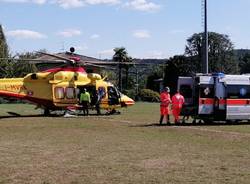UNIVA: “Tensions and uncertainties continue to dominate Varese’s economy”
These are the results of the economic survey of the first quarter: 47% of companies report a fall in production, and an increase in the use of social security measures
 The first months of 2013 were characterised again by tensions and uncertainties. This is the situation concerning local manufacturing that has emerged from the economic survey of the first quarter of the year, by the Union of Industrialists of Varese Province, UNIVA.
The first months of 2013 were characterised again by tensions and uncertainties. This is the situation concerning local manufacturing that has emerged from the economic survey of the first quarter of the year, by the Union of Industrialists of Varese Province, UNIVA.
PRODUCTION
In the production system in Varese, it is the companies that sell to non-EU countries, and who operate in highly specialised niche markets that have managed to hold out, although the results obtained by these are not sufficient to compensate entirely for the losses in the domestic market or in the European Union. Indeed, the weakness in domestic consumption continues to penalise most of the companies that operate in the domestic market, just as the European crisis is having an impact on the companies that export primarily to EU markets, who account for 50% of Varese exports.
The trend in production in the first quarter of 2013 reflects these difficulties, and the firms in the sample can be divided into those that have not seen any variations in the low production levels reached in the past months (49%) and those that have declared a decrease (47%). Only 4% have reported an increase in production.
|
VARESE PROVINCE Trend in production with respect to the previous quarter – Assessment of replies Source: Quarterly economic survey |
EXPECTATIONS
The current situation is affected by numerous risk factors that characterise the political and economic system, and that lead to forecasts for the next few months that remain cautiously conservative and highly volatile. Seventy one per cent of the companies interviewed do not foresee changes in production in the next quarter, and find it hard to have a clear view not only of the long term, but also of the short. On the other hand, 17% expect further deterioration, and only 12%, an improvement.
ORDERS
The activity on the order book remains steady, but low, albeit with a slight improvement: 54% of the companies interviewed reported no change in orders with respect to the previous quarter, 31% saw a growth, and 15%, a decrease. Despite being affected by the crisis and uncertainty in Italy, this data largely reflects the trend in foreign orders, which are more stable than domestic orders.
LABOUR MARKET
The labour market reflects the trends in the economy and production. Nationally, the number of people in employment has fallen, especially in the lower age ranges, and the unemployment rate has risen to 10.7% (the 2012 average, ISTAT). Locally, unemployment reached 8.5% in 2012.
The data relating to ordinary redundancy (CIGO) reflects these tensions: in the first quarter of 2013, 5,489,033 hours of CIGO were authorised in the industrial sector, an increase of 17.4% with respect to the first quarter of 2012. This figure, however, was a fall (of 23.9%) with respect to the last quarter of 2012. The increase in the number of hours of CIGO, with respect to last year, affected all sectors, with the exception of the textile-clothing and chemical and pharmaceutical sectors, which recorded a fall.
Looking at the trend in the use of the other social security measures, we see, for the industrial sector, an increase in the hours of extraordinary redundancy (CIGS) (+65.2% compared to the same period in 2012) and a reduction in the extended redundancy (-82.5%). Taking the ordinary, extraordinary and extended payments as a whole, a total of 9,250,573 hours were authorised, a 27% increase over the first quarter of 2012.
|
HOURS OF ORDINARY REDUNDANCY PAID PER YEAR IN THE INDUSTRIAL SECTOR IN VARESE
Source: revision by UNIVA, of data from the National Institute of Social Security, INPS |
INTERNATIONAL MARKETS: THE 2012 BALANCE
The latest data available concerning foreign trade by Varese companies relates to the whole of 2012, and shows that exports remained steady, thanks especially to the activity of non-EU markets, and that there was a fall in imports due to a fall in domestic demand.
In 2012, Varese exports reached €9917 million, an increase of 6.1% over 2011. On the other hand, imports fell by 10.9%, to €5797 million. The result is that the trade balance for Varese remained positive (+ €4120 million), an increase of 45.2% compared to 2011. Varese continues to be among the top ten exporting provinces in Italy. This is confirmed by the high ratio between exports and imports for the local economy, which shows that, in 2012, for every €100 imported, €171 was exported, which is well above the national average (€103).
An analysis of the reference markets for our exports highlights the difficulties that the countries in the European Union are experiencing, and outlines new paths for development. In 2012, Varese exports to the European Union, effectively remained stable (-0.7%) with respect to 2011; furthermore, there was a fall in the volume to France and Germany, the top two reference markets, which, together, account for 22% of trade out of the province. Exports to Germany gradually worsened during 2012 and, at the end of the year, showed an overall variation of -0.5% with respect to 2011. Exports towards France (the second reference market) fell by 3.7% in 2012, reflecting the initial signs of a worse crisis than was expected, and of a fall in consumption. On the other hand, Varese exports were driven by trade towards non-EU areas. Among the non-EU countries, there were significant increases in exports to Russia (+52%) and nearby Turkey (+44.3%). Of the emerging areas, performance was good to Africa (+31.2%) and the Middle East (+37.1%). In conclusion, there was also good stability in the US market (+6%), which, despite having an economic structure similar to that of the EU countries, was not affected as much by the crisis.
However, the overall positive result for exports was not across the board, but was limited to special production niches.
In the engineering industry, exports increased by 8.1%, compared to a decrease of 2.9% in imports. However, the exports varied from division to division; there was good performance by companies that manufacture machinery (+9.9%) and those that operate in the aerospace industry (+27.7%), but companies that manufacture electrical equipment and non-electrical household equipment showed signs of difficulty (-9.5%).
The textile and clothing industry recorded a fall in exports (-4.9%) and in imports (22.1%), in both textile products and clothing.
There were also falls in exports and imports in the rubber and plastics sector: -1.3% in exports, and -6.2% in imports.
On the other hand, the chemical and pharmaceutical sector showed increases in exports (2.2%), especially in the pharmaceutical division, and a significant decrease in imports (23.1%).
|
FOREIGN TRADE Varese Province |
January – December 2012 |
Variation with respect to January – December 2012 |
||
|
|
Imports (€) |
Exports (€) |
Imports % var. |
Exports % var. |
|
Engineering |
|
|
|
|
|
Textile-clothing |
|
|
|
|
|
Chemical and pharmaceutical |
|
|
|
|
|
Rubber and plastics |
|
|
|
|
|
Total for the Province |
|
|
|
|
|
Trade balance |
|
|
|
|
|
Source: ISTAT. Coeweb provisional data |
||||
TRENDS BY SECTOR
Engineering sector. In the first quarter of 2013, the engineering sector generally remained stable with respect to the previous quarter; this was due, however, to different trends in the different reference divisions; the companies that operate in particular, highly specialised production niches performed better, whereas those more linked to the final consumption market, above all the domestic market, suffered.
In the production sector, most of the companies interviewed (71%) reported no change in production levels with respect to the previous quarter, but 28% reported falls.
Stability is expected in the short term, with 72% of the companies analysed predicting a continuation of the current production levels. The number of orders in the first quarter of 2013 was stable, according to 68% of the companies interviewed. However, 28% of the sample reported improvements in the orders, driven by orders from foreign markets.
Textile and clothing sector. In the textile and clothing sector, there was an economic slowdown in the first quarter of 2013, after the technical rebound at the end of 2012. In production, most of the companies interviewed reported a deterioration with respect to the previous quarter, which was due, in part, also to seasonal factors typical of this sector.
The short-term forecasts are for a cautious trend, with 75% of the companies that took part in the survey expecting stability in the production levels.
On the other hand, the order books in the first quarter of the year showed variation: 47% of the companies in the sample claimed, on the whole, that orders had remained stable with respect to the previous quarter, 22% reported a decrease, and 31%, an increase.
Chemical and pharmaceutical industry. The economic situation in the chemical and pharmaceutical sector remained stable. In production, in the first quarter of 2013, most of the businesspeople interviewed (69%) claimed that production levels had not changed compared to the previous quarter.
The short-term forecasts are for stability, however, they reflect companies’ difficulty to make any mid-term or long-term forecasts. Sixty six per cent of the companies in the sample forecast that the current production levels will be maintained.
The number of orders on the books is positive, with 70% of the companies interviewed reporting an increase, driven mostly by the foreign markets: 77% of the sample reported an increase in foreign orders. Compared to the other sectors analysed, the percentage of replies highlights a low level of stability in total orders (7%).
Rubber and plastics sector. In the first quarter of 2013, companies in the rubber and plastics sector felt the effects of the difficulties in the economy: 45% of the companies in the sample reported a fall in production with respect to the previous quarter, compared to 41%, who reported stability, and 14% who reported growth.
In the short-term, the companies expect stability or a slight improvement in the current low production levels: 59% of the companies in the sample do not expect any changes, whereas 41% expect an increase.
The number of orders on the books reflects production: 45% of the sample analysed had seen a fall in the total number of orders, 45% reported no variations, and 10% had seen an increase. Analysing the data concerning foreign orders, we can see that the situation is stable, with 78% of the sample interviewed claiming not to have seen any variations in the orders from foreign countries, whereas 18% reported an increase.
La community di VareseNews
Loro ne fanno già parte
Ultimi commenti
Emanuele Zanetti su Motociclista di Ferno ucciso da un orso in Romania
GrandeFratello su Superate le 700 firme per la petizione sul recupero del Grand Hotel Campo dei Fiori di Varese
Felice su Motociclista di Ferno ucciso da un orso in Romania
Stefano64 su Neil Young torna dopo l'enorme successo di Harvest: ma non è il disco che tutti si aspettano
Alessandro Zanzi su Superate le 700 firme per la petizione sul recupero del Grand Hotel Campo dei Fiori di Varese
Felice su La bibliocabina, la panchina e il cane che fa pipì. A Fagnano Olona scoppia la polemica
















Accedi o registrati per commentare questo articolo.
L'email è richiesta ma non verrà mostrata ai visitatori. Il contenuto di questo commento esprime il pensiero dell'autore e non rappresenta la linea editoriale di VareseNews.it, che rimane autonoma e indipendente. I messaggi inclusi nei commenti non sono testi giornalistici, ma post inviati dai singoli lettori che possono essere automaticamente pubblicati senza filtro preventivo. I commenti che includano uno o più link a siti esterni verranno rimossi in automatico dal sistema.